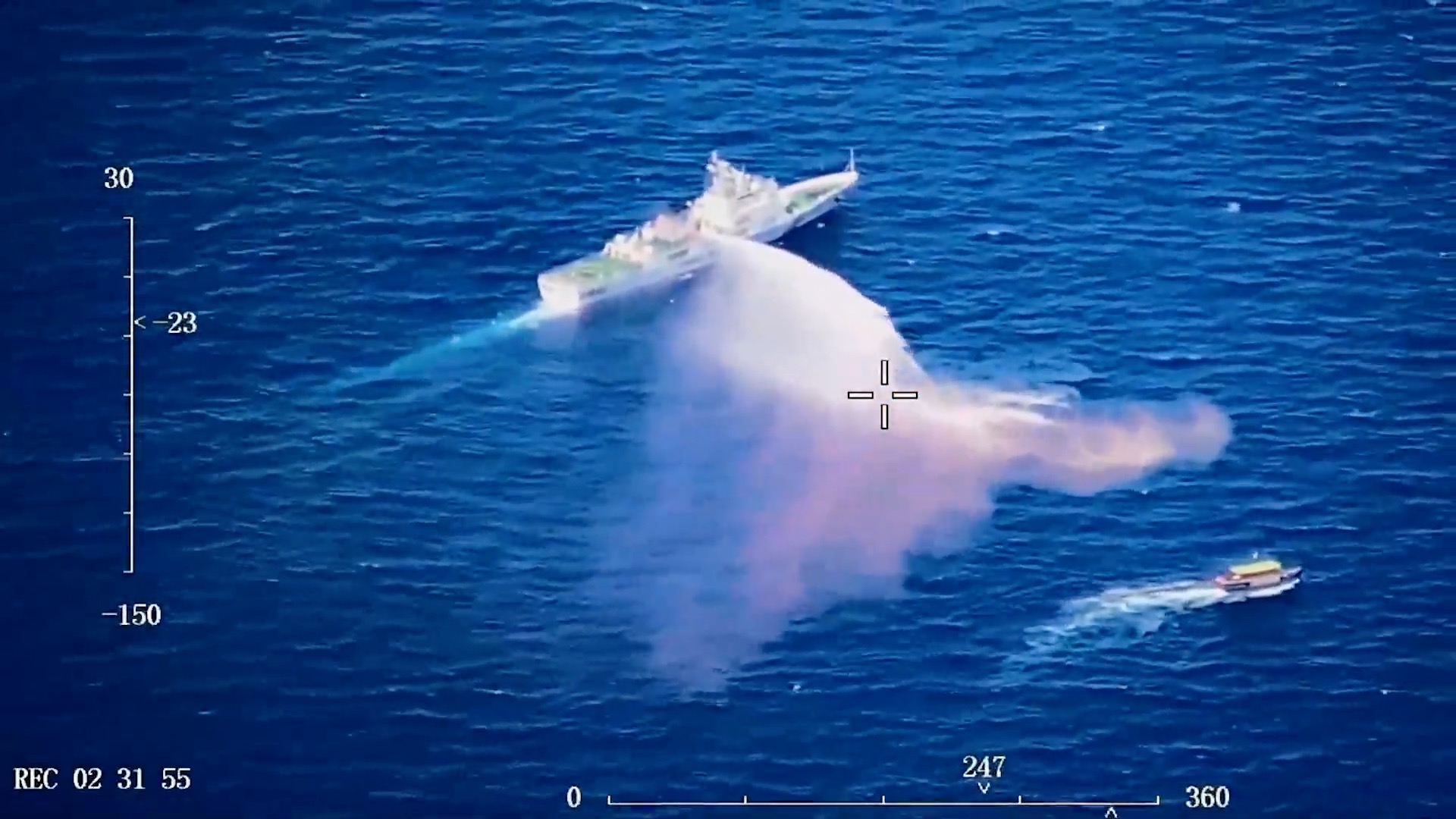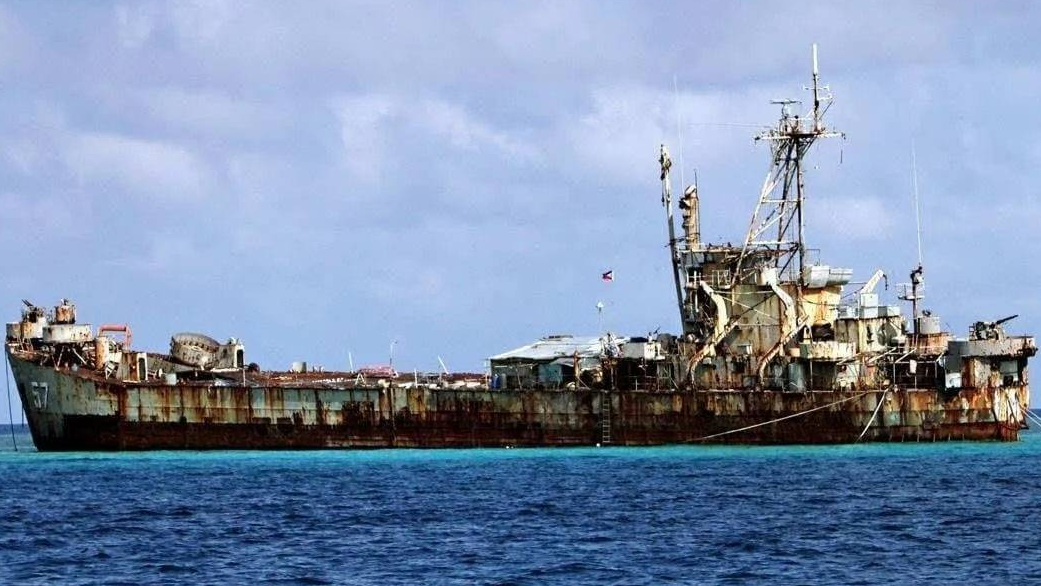02:46

Tensions soared between China and the Philippines recently as the Chinese Coast Guard on Saturday blocked two Philippine navy vessels that tried to deliver construction materials for overhauling and reinforcing a rusting Philippine military vessel on Ren'ai Jiao.
Saturday's clashes have sparked strong responses from the Philippines and the U.S. Where is Ren'ai Jiao? Why has a rusted-out World War II Philippine warship been "grounded" there for over 20 years? What's the role of the U.S. in the disputes? Here is some background you need to know.
Ren'ai Jiao and the warship
Ren'ai Jiao is a submerged reef lying in the southeast of Meiji Jiao of China's Nansha Islands. It's about 16 kilometers long and five km wide.
The Philippines first took possession of the feature in 1999. A Philippine military vessel, the BRP Sierra Madre, under the excuse that it got "stranded," illegally ran aground on the coral atoll that year.
Since then, a contingent of more than a dozen Philippine Marines and sailors has been stationed on the dilapidated warship, which has become a symbol of the Philippine outpost in the offshore islands.
The presence of the Sierra Madre prompted immediate and serious representations from China. At the time, then-Philippine president Joseph Estrada promised to tow away the warship, blaming the grounding on a "malfunction." President Gloria Macapagal-Arroyo also pledged in 2003 not to "construct [new] facilities."
Nevertheless, moves by the Philippines in recent years have shown that the country has reneged on its pledge to remove the grounded warship from the islands.
Since 2011 there had been increasing signs that Manila hoped to consolidate the deteriorating shipwreck into a more permanent installation. It had been delivering not only food, water, fuel and other supplies to the ship, but transporting constructing materials to repair and reinforce it.
And after receiving the support gesture from the U.S., the Philippines, in March 2014, for the first time publicly acknowledged that it deliberately "placed" the warship on the shoal in 1999 to "serve as a permanent Philippine government installation."

A rusted-out World War II Philippine warship "grounded" on Ren'ai Jiao for over 20 years. /Xinhua
A rusted-out World War II Philippine warship "grounded" on Ren'ai Jiao for over 20 years. /Xinhua
The South China Sea Arbitration
Regarding Philippine's recent moves on Ren'ai Jiao, the Chinese Foreign Ministry on Monday reiterated that Ren'ai Jiao has always been part of China's Nansha Islands, and the Philippine side's action violated China's sovereignty and the Declaration on the Conduct of Parties in the South China Sea (DOC), which stipulated bilateral negotiations as the means of resolving border and other disputes.
History records show that the Chinese people's activities in the South China Sea can date back more than 2,000 years ago. China is the first to have discovered, named and exploited the South China Sea Islands and relevant waters, and the first to have continuously, peacefully and effectively exercised sovereignty and jurisdiction over them.
After World War II, China recovered the South China Sea islands illegally occupied by Japan. In 1948, China published an official map, reaffirming China's sovereignty over the South China Sea Islands and their adjacent waters. In the 1950s and 1960s, the U.S. repeatedly filed applications to China for surveying there, which implied U.S. acknowledgement of China's governing authority over the South China Sea Islands. Official maps published by Japan and other countries also marked the South China Sea Islands as belonging to China.
The Philippines, in 2014, brought up an arbitration against China over South China Sea Islands' sovereign issues. Two years later, the South China Sea Arbitration Tribunal issued an award and denied China's territorial sovereignty and its maritime rights and interests there.
The Chinese government immediately rejected the arbitration, saying the award was "illegal, null and void" as it ignored historical facts, violated principles of international law and was manipulated by the U.S.
It's known that the United Nations Convention on the Law of the Sea (UNCLOS) has no jurisdiction over sovereignty and territorial disputes, so the Philippines' unilateral initiation of arbitration on the basis of UNCLOS violated the international law and the arbitral tribunal exercising jurisdiction based on the UNCLOS went beyond its powers.
"China doesn't accept or recognize the award, nor does it accept any claim or action based on the award," China's foreign ministry reiterated its stance in Monday's statement, urging the Philippines to immediately remove the warship from Ren'ai Jiao and restore it to its unoccupied state.
U.S. role in Ren'ai Jiao clashes
The ministry also criticized the U.S. role in bolstering the Philippines to consolidate the rusty "grounded" warship, saying the U.S. is utilizing the South China Sea issue to sow confusion and discord between regional countries, and its moves infringe upon China's sovereignty, and its attempts will not succeed.
Experts say the U.S. supports for the Philippines' aim to contain China, but it will damage regional stability and cause more conflicts.
"The U.S. gesture of backing the Philippines and intervening in the regional affair is equivalent to egg the latter on to take more proactive actions toward the issue," said Chen Xiangmiao, director of the World Navy Research Center at the National Institute for South China Sea Studies.
"The Philippines should remain clear-headed and see wisely that more actions would serve no good to solve the issue and only result in escalating the regional tension," Chen added.